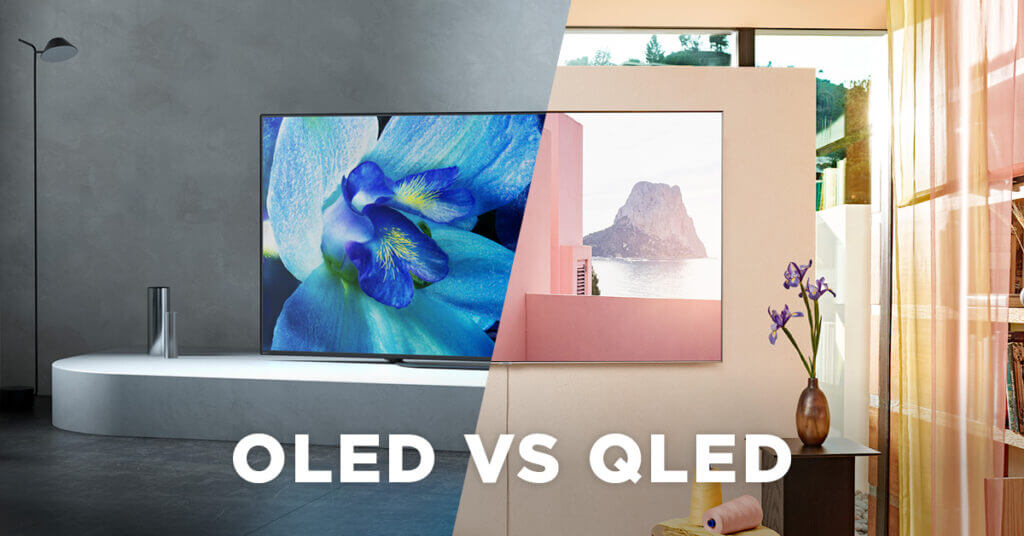
If you are thinking of buying a new branded TV, you will notice some brands are selling OLED TVs while others are promoting QLED televisions, so the question that comes to mind is which technology is better? In this OLED vs QLED guide, we will be addressing that question and comparing QLED vs OLED technology to find which will be best for you.
Even though the term OLED and QLED sound similar, they are two completely different technology. OLED technology is also known as an organic light-emitting diode, which in simple English means self-emissive light. QLED stands for quantum-dot Light-Emitting Diode. The configuration of QLED TVs is similar to regular LED TVs.
How LED technology works?
Before starting the comparison between OLED and QLED TV, let see how regular LED technology work.
Except for OLED TV, all other TVs, whether it is a 4K TV, Full HD TV, or even QLED TV, work on LED technology, where at the backside of the screen of those TVs there is an LED light. In LED technology, the picture quality of the TV depends upon where the LED lights are placed. Generally, LED lights are placed at the back of the screen, known as DLED backlighting, or in some TVs, the LEDs are put at the corner of the screen, known as ELED. If a TV is slim in design, then that TV is using ELED backlighting.
The picture quality of LED TV depends upon the quality and quantity of the LED backlights used on that TV. Picture quality also depends on the number of pixels in a display.
Those LED lights charged the pixels, which create images so that you can watch the TV. If you don’t know what pixels are? or what it means, then consider pixels as small dots which, when combined, makes a picture.
OLED vs QLED
OLED Technology
OLED TVs first arrived at the market in 2013, and since then, they are known for their perfect colors and black levels. OLED is a costly technology, and that’s why you will notice that OLED TVs are generally more expensive, but in recent years we have seen a price has dropped of OLED TVs’ thanks to innovation in OLED technology.
The OLED display is made up of 6 layers. In OLED display, every single pixel can separately turn on/off, which is why in OLED display, you get better blacks.
Also, as OLED doesn’t need a backlight to display pictures on the screen as it can radiate light, that’s the reason why OLED TVs are so slim in design.
The OLED display also consumes less power than the QLED or LED display. The material used in OLED displays is environment friendly, and also, watching content on OLED TV will not harm your eyes. The newest QLED TVs on the market at The Electronics Warehouse.
Other than its deeper blacks, the contrast ratio that you get in OLED TV is excellent. You can watch action movies on an OLED display with no motion blur. OLED TVs have wide viewing angles of almost 178°.
OLED displays are known for their amazing color reproduction capabilities and sharpness. But, the brightness level of the OLED display is low compared to the QLED display.
If you have a gaming console or think of buying one, then OLED TV would be a better option for you for gaming; you will notice the great richness and details on the display that you can not get on a QLED display.
Advantages of OLED TV
- Thinner and lighter compared to LED, LCD, and QLED TVs
- The contrast of OLED TVs are way better than LED and LCD TVs
- OLED TVs are known for there deeper black levels
- Good for gaming
- OLED TV consumes less power
Disadvantages of OLED TV
- In OLED TVs, you will get fewer brightness levels then QLED
- The OLED display is costly than LED and QLED display
- The major disadvantage of OLED TV is that in OLED TVs, you can get burn-in issues on the screen, especially where there is the logo of the channel if you are watching the same channel continuously.
QLED Technology
Samsung’s new flagship TV range had taken a new form since 2017 when they decided to leave their HD models behind. The new QLED lineup of Samsungs TVs promises to deliver 4K HDR visual thanks to QLED or quantum dots technology.
What is a quantum dot you as?
QLED is an LCD screen that has a quantum dot filter in it. This filter manages and improves the colors and white level of the panel. This panel requires a separate lighting source, which is why you get LED lights behind the panel. QLED TV launched before 2018 was using ELED backlighting, but now they use DLED backlighting.
It can sometimes get frustrating when you are watching TV, and you see the reflection of the light coming from the windows and reflecting on your TV screen. This can never happen on a QLED TV as the panel of a QLED TV is dependent on an internal lightning source, so no external light will affect the color, contrast, and brightness.
An OLED screen can give you a maximum brightness of 1000 nits, but a QLED screen can easily give you a brightness of 2000 nits, with 2000 nits of brightness that you get in a QLED screen. You can watch movies on true HDR and watch sports like football and baseball on the QLED TV, which is a great experience that you cannot get in OLED TVs due to their low brightness.
In QLED TV, you will get a brighter image with even more vibrant colors. Best of all, it is done with less energy too, and unlike the traditional LED display.
Advantages of QLED TVs
- QLED TVs are known for there high brightness
- QLED TVs are more affordable, and there are also more models available at different prices.
- You can use a QLED TV as a monitor without worrying about burn-in issues
- Colors on QLED TVs look fantastic as in QLED TV you will get complete color accuracy
- QLED TVs has no burn-in issues
Disadvantages of QLED TVs
- QLED TVs have poor viewing angles
- Response time of QLED display is slower compared to OLED display
- QLED display cannot produce those deep black color which you get in an OLED display.
Conclusion
Now you know everything about OLED and QLED technology; OLED display has deeper blacks, wide viewing angle, excellent contrast level, and very slim design.
LG is the biggest maker of an OLED display. That’s why you will find the most affordable OLED TV from LG. They are the one who sells their OLED screens to other brands like Sony, Panasonic.
Although all these brands use OLED screens made by LG still, you will find a different color profile on their TVs as every brand does their color management differently. Every brand has different chips that handle the contrast and colors of that TV differently.
Samsung is the QLED screen manufacturer, and Samsung also supplies its QLED screen to other brands. Still, you won’t get the most affordable QLED TV by Samsung because Samsung puts the best colors on their TVs, which is why their TVs are so expensive.
If you are still confused between OLED and QLED, then consider this.
You should go for an OLED TV if you don’t use the TV for more than two to three hours a day or only watch TV at night. You should buy a QLED TV if you have too much light coming to your house or if you love watching sports or if you like to watch TV with lights on.

I’m Mr.Love . I’m admin of Techsmartest.com



![How to Watch UFC 303 Live Stream Free [Updated 2024] UFC 259 Live Stream Free](https://techsmartest.com/wp-content/uploads/2022/03/UFC-259-Live-Stream-Free-218x150.jpg)
![How to Access UFC 302 Live Stream Free [Updated 2024] UFC 260 Live Stream Free](https://techsmartest.com/wp-content/uploads/2022/03/UFC-260-Live-Stream-Free-218x150.jpg)





![How to Watch UFC 303 Live Stream Free [Updated 2024] UFC 259 Live Stream Free](https://techsmartest.com/wp-content/uploads/2022/03/UFC-259-Live-Stream-Free-100x70.jpg)
![How to Access UFC 302 Live Stream Free [Updated 2024] UFC 260 Live Stream Free](https://techsmartest.com/wp-content/uploads/2022/03/UFC-260-Live-Stream-Free-100x70.jpg)






